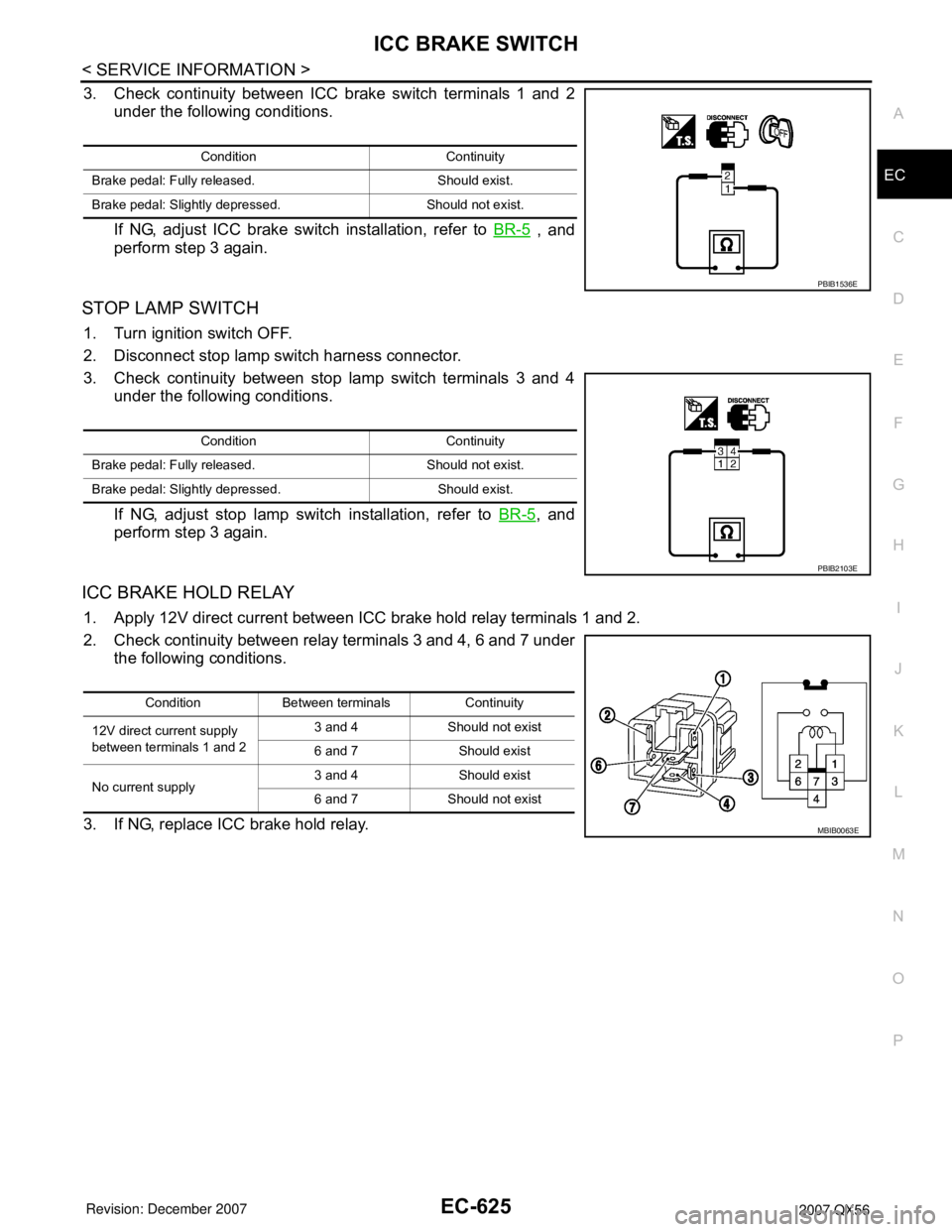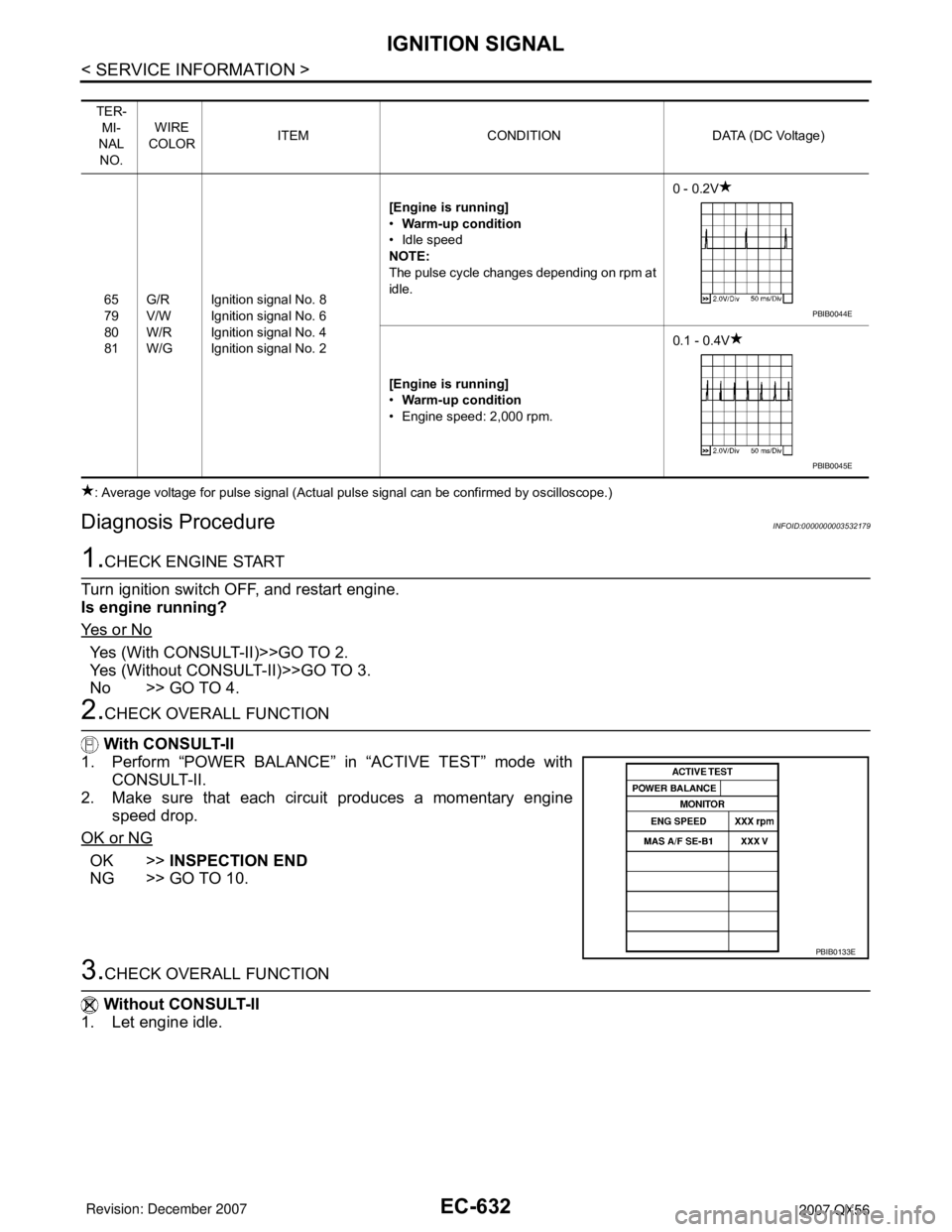Page 1708 of 3061

ICC BRAKE SWITCH
EC-625
< SERVICE INFORMATION >
C
D
E
F
G
H
I
J
K
L
MA
EC
N
P O
3. Check continuity between ICC brake switch terminals 1 and 2
under the following conditions.
If NG, adjust ICC brake switch installation, refer to BR-5
, and
perform step 3 again.
STOP LAMP SWITCH
1. Turn ignition switch OFF.
2. Disconnect stop lamp switch harness connector.
3. Check continuity between stop lamp switch terminals 3 and 4
under the following conditions.
If NG, adjust stop lamp switch installation, refer to BR-5
, and
perform step 3 again.
ICC BRAKE HOLD RELAY
1. Apply 12V direct current between ICC brake hold relay terminals 1 and 2.
2. Check continuity between relay terminals 3 and 4, 6 and 7 under
the following conditions.
3. If NG, replace ICC brake hold relay.
Condition Continuity
Brake pedal: Fully released. Should exist.
Brake pedal: Slightly depressed. Should not exist.
PBIB1536E
Condition Continuity
Brake pedal: Fully released. Should not exist.
Brake pedal: Slightly depressed. Should exist.
PBIB2103E
Condition Between terminals Continuity
12V direct current supply
between terminals 1 and 23 and 4 Should not exist
6 and 7 Should exist
No current supply3 and 4 Should exist
6 and 7 Should not exist
MBIB0063E
Page 1709 of 3061
EC-626
< SERVICE INFORMATION >
IGNITION SIGNAL
IGNITION SIGNAL
Component DescriptionINFOID:0000000003532177
IGNITION COIL & POWER TRANSISTOR
The ignition signal from the ECM is sent to and amplified by the power transistor. The power transistor turns
ON and OFF the ignition coil primary circuit. This ON/OFF operation induces the proper high voltage in the coil
secondary circuit.
1. Ignition coils (with power transistor)
(bank 2)2. Ignition coils (with power transistor)
(bank 1)
BBIA0777E
Page 1710 of 3061
IGNITION SIGNAL
EC-627
< SERVICE INFORMATION >
C
D
E
F
G
H
I
J
K
L
MA
EC
N
P O
Wiring DiagramINFOID:0000000003532178
Specification data are reference values and are measured between each terminal and ground.
CAUTION:
Do not use ECM ground terminals when measuring input/output voltage. Doing so may result in dam-
age to the ECM's transistor. Use a ground other than ECM terminals, such as the ground.
BBWA2107E
Page 1711 of 3061
EC-628
< SERVICE INFORMATION >
IGNITION SIGNAL
TER-
MI-
NAL
NO.WIRE
COLORITEM CONDITION DATA (DC Voltage)
111 W / BECM relay
(Self shut-off)[Engine is running]
[Ignition switch: OFF]
• For a few seconds after turning ignition
switch OFF0 - 1.5V
[Ignition switch: OFF]
• More than a few seconds after turning igni-
tion switch OFFBATTERY VOLTAGE
(11 - 14V)
11 9
120BR
BRPower supply for ECM[Ignition switch: ON]BATTERY VOLTAGE
(11 - 14V)
Page 1712 of 3061
IGNITION SIGNAL
EC-629
< SERVICE INFORMATION >
C
D
E
F
G
H
I
J
K
L
MA
EC
N
P O
Specification data are reference values and are measured between each terminal and ground.
Pulse signal is measured by CONSULT-II.
CAUTION:
Do not use ECM ground terminals when measuring input/output voltage. Doing so may result in dam-
age to the ECM's transistor. Use a ground other than ECM terminals, such as the ground.
BBWA1871E
Page 1713 of 3061
EC-630
< SERVICE INFORMATION >
IGNITION SIGNAL
: Average voltage for pulse signal (Actual pulse signal can be confirmed by oscilloscope.)TER-
MI-
NAL
NO.WIRE
COLORITEM CONDITION DATA (DC Voltage)
46
60
61
62L/R
GR/R
O/W
Y/RIgnition signal No. 7
Ignition signal No. 5
Ignition signal No. 3
Ignition signal No. 1[Engine is running]
•Warm-up condition
• Idle speed
NOTE:
The pulse cycle changes depending on rpm at
idle.0 - 0.2V
[Engine is running]
•Warm-up condition
• Engine speed: 2,000 rpm.0.1 - 0.4V
PBIB0044E
PBIB0045E
Page 1714 of 3061
IGNITION SIGNAL
EC-631
< SERVICE INFORMATION >
C
D
E
F
G
H
I
J
K
L
MA
EC
N
P O
Specification data are reference values and are measured between each terminal and ground.
Pulse signal is measured by CONSULT-II.
CAUTION:
Do not use ECM ground terminals when measuring input/output voltage. Doing so may result in dam-
age to the ECM's transistor. Use a ground other than ECM terminals, such as the ground.
BBWA1712E
Page 1715 of 3061

EC-632
< SERVICE INFORMATION >
IGNITION SIGNAL
: Average voltage for pulse signal (Actual pulse signal can be confirmed by oscilloscope.)
Diagnosis ProcedureINFOID:0000000003532179
1.CHECK ENGINE START
Turn ignition switch OFF, and restart engine.
Is engine running?
Ye s o r N o
Yes (With CONSULT-II)>>GO TO 2.
Yes (Without CONSULT-II)>>GO TO 3.
No >> GO TO 4.
2.CHECK OVERALL FUNCTION
With CONSULT-II
1. Perform “POWER BALANCE” in “ACTIVE TEST” mode with
CONSULT-II.
2. Make sure that each circuit produces a momentary engine
speed drop.
OK or NG
OK >>INSPECTION END
NG >> GO TO 10.
3.CHECK OVERALL FUNCTION
Without CONSULT-II
1. Let engine idle.
TER-
MI-
NAL
NO.WIRE
COLORITEM CONDITION DATA (DC Voltage)
65
79
80
81G/R
V/W
W/R
W/GIgnition signal No. 8
Ignition signal No. 6
Ignition signal No. 4
Ignition signal No. 2[Engine is running]
•Warm-up condition
• Idle speed
NOTE:
The pulse cycle changes depending on rpm at
idle.0 - 0.2V
[Engine is running]
•Warm-up condition
• Engine speed: 2,000 rpm.0.1 - 0.4V
PBIB0044E
PBIB0045E
PBIB0133E